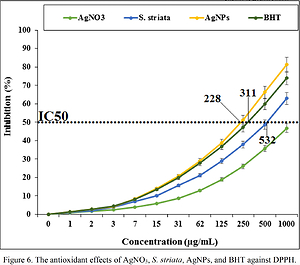Current issue
Archive
Manuscripts accepted
About the Journal
Editorial office
Editorial board
Section Editors
Abstracting and indexing
Subscription
Contact
Ethical standards and procedures
Most read articles
Instructions for authors
Article Processing Charge (APC)
Regulations of paying article processing charge (APC)
PHARMACOLOGY AND PHARMACY / EXPERIMENTAL RESEARCH
A comparative experiment on the anti-chronic myeloid leukemia capacities of AgNO3, Scrophularia striata leaf aqueous extract, and silver nanoparticles containing natural compounds
1
Department of Hematology and Oncology, Heji Hospital Affiliated to Changzhi Medical College, Changzhi, China
2
Department of Pediatrics, Arak University of Medical Sciences, Arak, Iran
3
School of Dentistry, Kermanshah University of Medical Sciences, Iran
4
Department of General Surgery, Faculty of Medicine, Ilam University of Medical Sciences, Ilam, Iran
5
Biotechnology and Medicinal Plants Research Center, Ilam University of Medical Sciences, Ilam, Iran
6
Department of Clinical Biochemistry, Faculty of Medicine, Ilam University of Medical Sciences, Ilam, Iran
Submission date: 2021-07-21
Final revision date: 2021-11-14
Acceptance date: 2021-11-15
Online publication date: 2022-01-02
Corresponding author
Mohammad Mahdi Zangeneh
Biotechnology and Medicinal Plants Research Center, Ilam University of Medical Sciences, Ilam, Iran, Iran
Biotechnology and Medicinal Plants Research Center, Ilam University of Medical Sciences, Ilam, Iran, Iran
KEYWORDS
TOPICS
ABSTRACT
Introduction:
In the current study, silver nanoparticles were prepared and synthesized in aqueous medium using the Scrophularia striata leaf extract as stabilizing and reducing agents. Also, we investigated the anti-chronic myeloid leukemia potentials of silver nanoparticles against BV173 (chronic myeloid leukemia in blast crisis), CML-T1 (chronic myeloid leukemia in lymphoid blast crisis), EM-2 (chronic myeloid leukemia in blast crisis; relapse after bone marrow transplantation), and JOSK-M (chronic myeloid leukemia in myelomonocytic) cell lines.
Material and methods:
Silver nanoparticles were characterized and analyzed using common nanotechnology techniques including UV-Vis and FT-IR Spectroscopy, Field Emission-Scanning Electron Microscopy (FE-SEM), Transmission Electron Microscopy (TEM), and Energy Dispersive X-ray Spectrometry (EDS). FT-IR analysis offered antioxidant compounds in the nanoparticles were the sources of reducing power, reducing silver ions to silver nanoparticles. FE-SEM and TEM images revealed a uniform spherical morphology in size of 19.72 nm for the green synthesized nanoparticles. DPPH test revealed similar antioxidant potentials for silver nanoparticles and butylated hydroxytoluene.
Results:
Silver nanoparticles had very low cell viability and anti-chronic myeloid leukemia properties dose-dependently against JOSK-M, EM-2, CML-T1, and BV173 cell lines without any cytotoxicity on the HUVEC cell line. The best result of cytotoxicity properties of silver nanoparticles against the above cell lines was observed in the case of CML-T1 cell line.
Conclusions:
After confirming in the in vivo and clinical trial studies, these nanoparticles can be administered to humans for the treatment of chronic myeloid leukemia.
In the current study, silver nanoparticles were prepared and synthesized in aqueous medium using the Scrophularia striata leaf extract as stabilizing and reducing agents. Also, we investigated the anti-chronic myeloid leukemia potentials of silver nanoparticles against BV173 (chronic myeloid leukemia in blast crisis), CML-T1 (chronic myeloid leukemia in lymphoid blast crisis), EM-2 (chronic myeloid leukemia in blast crisis; relapse after bone marrow transplantation), and JOSK-M (chronic myeloid leukemia in myelomonocytic) cell lines.
Material and methods:
Silver nanoparticles were characterized and analyzed using common nanotechnology techniques including UV-Vis and FT-IR Spectroscopy, Field Emission-Scanning Electron Microscopy (FE-SEM), Transmission Electron Microscopy (TEM), and Energy Dispersive X-ray Spectrometry (EDS). FT-IR analysis offered antioxidant compounds in the nanoparticles were the sources of reducing power, reducing silver ions to silver nanoparticles. FE-SEM and TEM images revealed a uniform spherical morphology in size of 19.72 nm for the green synthesized nanoparticles. DPPH test revealed similar antioxidant potentials for silver nanoparticles and butylated hydroxytoluene.
Results:
Silver nanoparticles had very low cell viability and anti-chronic myeloid leukemia properties dose-dependently against JOSK-M, EM-2, CML-T1, and BV173 cell lines without any cytotoxicity on the HUVEC cell line. The best result of cytotoxicity properties of silver nanoparticles against the above cell lines was observed in the case of CML-T1 cell line.
Conclusions:
After confirming in the in vivo and clinical trial studies, these nanoparticles can be administered to humans for the treatment of chronic myeloid leukemia.
Share
RELATED ARTICLE
We process personal data collected when visiting the website. The function of obtaining information about users and their behavior is carried out by voluntarily entered information in forms and saving cookies in end devices. Data, including cookies, are used to provide services, improve the user experience and to analyze the traffic in accordance with the Privacy policy. Data are also collected and processed by Google Analytics tool (more).
You can change cookies settings in your browser. Restricted use of cookies in the browser configuration may affect some functionalities of the website.
You can change cookies settings in your browser. Restricted use of cookies in the browser configuration may affect some functionalities of the website.



